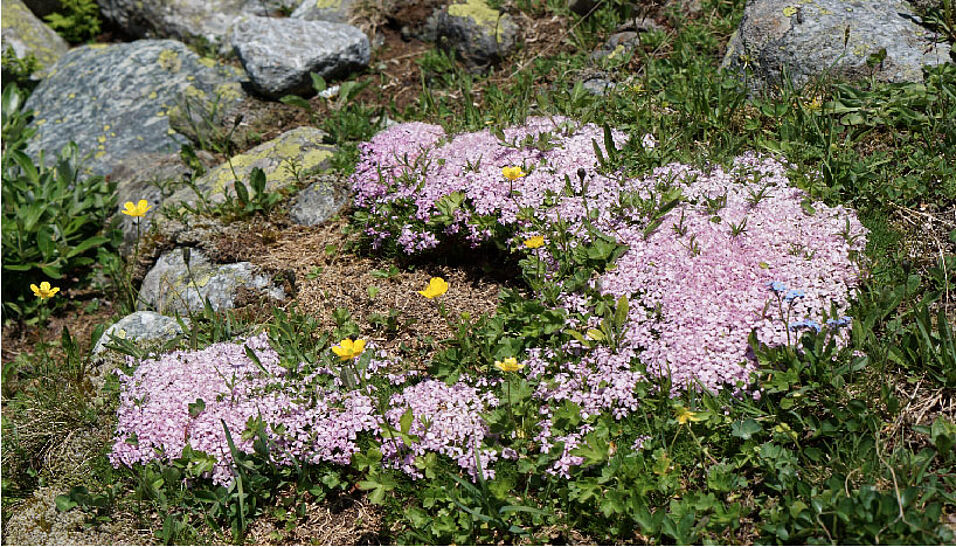In response to climate warming, plant species adapted to cold temperatures are retreating to cooler regions, such as higher elevations in the mountains. However, individuals of a species can differ in their climatic requirements. It is poorly understood how a warmer climate affects the relative abundance of cold- and warm-adapted individuals or genotypes within a certain species. Scientists at the University of Vienna and the University of Helsinki have now integrated assumptions about individual variation in climatic demands into a migration model for mountain plants. The surprising result of the model calculation: while species migrate to higher mountain regions, cold-adapted genotypes become more frequent, and heat-adapted ones less frequent. The study appears in the journal Nature Climate Change.
Many studies show that animal and plant species are responding to recent climate warming. Shifts to colder climate zones, from the equator to the poles or to higher elevations in the mountains are particularly well documented. Model calculations predict that these shifts will accelerate in the coming years. However, what is rarely considered in these model calculations is individual variation within species, whether they be better adapted for colder or for warmer conditions. Natural selection from this variation, in particular selection of warmth-adapted genotypes, is generally considered a possible strategy of species to cope with a warming climate, but these differences within species and their possible effects for climate change adaptation are poorly understood.
A team of biologists from the University of Vienna and the University of Helsinki has now integrated the migration as well as the selection processes into a model. The scientists simulated the response of six alpine plants to different scenarios of climate warming. In the absence of empirical data, individuals of a species were hypothetically differentiated into heat- and cold- adapted genotypes. At the end of the modeling period, in 2080, changes in distribution area and relative abundance of warm- and cold-adapted genotypes within species were accounted for.
Counter-intuitive decline in heat-adapted individuals
Consistent with previous studies, the model calculations suggest that the ranges and populations of mountain plants will shrink in a warmer climate because their refugia occupy smaller areas at higher elevations. However, surprisingly in the simulations, warm-adapted genotypes become relatively rarer, and cold-adapted ones become more common. "This trend is seen in five out of six species and contradicts the intuitive expectation that a warmer climate should favor those individuals that are better able to cope with warmer conditions" says Johannes Wessely of the Department of Botany and Biodiversity Research at the University of Vienna, the study's lead author.
The surprising result can be explained by competition between individuals of a species. The cold-adapted genotypes at the cool edge of the range advance into "new territory" during climate change-triggered migration; they encounter no intraspecies-competitors during expansion into even colder regions. In contrast, the warm-adapted genotypes from the lower, warmer edge of their range find themselves in a catch-22 situation. The areas above their current range are already occupied by other individuals of the species, which impede or at least delay their higher migration. At the same time, the climate at the current lower edge of the range is becoming too hot even for the individuals best adapted to warm conditions.
Plausible scenario, but no prediction
"These results contradict the expectation that selection of heat-adapted genotypes could lead to a relatively rapid and successful adaptation of mountain plants to climate change" says Wessely. However, the scientist also emphasizes that the study is a model calculation based on many assumptions. "We know far too little about the variation of climate requirements between individuals of mountain plants, their genetic basics and their evolutionary adaptation capabilities to be able to make concrete predictions in this regard" adds project leader Stefan Dullinger. "What the results suggest, however, is that counter-intuitive selection of genotypes is a plausible scenario that could hinder rather than facilitate the adaptation of mountain plants to climate change. These results underscore both the need to mitigate climate warming and the call for expanding protected areas to free up species to adapt to climate change."
Publication in Nature Climate Change:
Wessely, J., Gattringer, A., Guillaume, F., Hülber, K., Klonner, G., Moser, D. & Dullinger, S.: Climate warming may increase the frequency of cold adapted haplotypes in alpine plants. Nature Climate Change. https://www.nature.com/articles/s41558-021-01255-8

